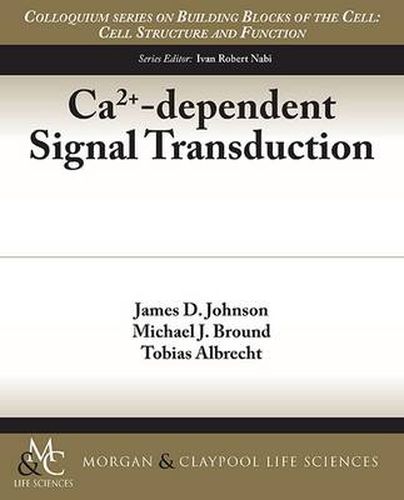Readings Newsletter
Become a Readings Member to make your shopping experience even easier.
Sign in or sign up for free!
You’re not far away from qualifying for FREE standard shipping within Australia
You’ve qualified for FREE standard shipping within Australia
The cart is loading…






In biology, signal transduction is the transmission of information into and within the cell. Signal transduction events within a cell are often initiated from an extracellular cue. Current knowledge suggests that there are far fewer intracellular second messengers than extracellular cues. This means that a conserved core set of second messengers, including ions, small nucleotides, and lipids must be coordinated to pass the information from their point of origin to their audience receptors effectively. In many cases, signal transduction involves significant amplification. One of the best-understood and ubiquitous second messengers is ionic calcium (Ca2+). The knowledge surrounding the coding of information via Ca2+ signals has served as a template for studying other second messengers. Ca2+ signaling and intracellular Ca2+ homeostasis are highly complex and still incompletely understood. In this chapter, will we review the current knowledge of Ca2+ signaling. We will first provide a review of the general principles of Ca2+ signal transduction and examples of some of the major Ca2+-dependent cellular processes. Next, we will review the main sources of Ca2+ and the molecular effectors of Ca2+ signals. Then, we will provide some examples from the literature that illustrate how Ca2+ signaling works: how it can mediate signal amplification, how it encodes different types of signals, how it performs agonist-specific signals as well as function-specific signals, signal integration and co-incidence detection, and how it can cross-talk with other second messenger signaling events. Throughout this chapter, we will use Ca2+ as an example of a prototypical coded second messenger, since it is clear that much of the complexity of Ca2+ signaling likely applies to many of the other known second messengers.
$9.00 standard shipping within Australia
FREE standard shipping within Australia for orders over $100.00
Express & International shipping calculated at checkout
Stock availability can be subject to change without notice. We recommend calling the shop or contacting our online team to check availability of low stock items. Please see our Shopping Online page for more details.
In biology, signal transduction is the transmission of information into and within the cell. Signal transduction events within a cell are often initiated from an extracellular cue. Current knowledge suggests that there are far fewer intracellular second messengers than extracellular cues. This means that a conserved core set of second messengers, including ions, small nucleotides, and lipids must be coordinated to pass the information from their point of origin to their audience receptors effectively. In many cases, signal transduction involves significant amplification. One of the best-understood and ubiquitous second messengers is ionic calcium (Ca2+). The knowledge surrounding the coding of information via Ca2+ signals has served as a template for studying other second messengers. Ca2+ signaling and intracellular Ca2+ homeostasis are highly complex and still incompletely understood. In this chapter, will we review the current knowledge of Ca2+ signaling. We will first provide a review of the general principles of Ca2+ signal transduction and examples of some of the major Ca2+-dependent cellular processes. Next, we will review the main sources of Ca2+ and the molecular effectors of Ca2+ signals. Then, we will provide some examples from the literature that illustrate how Ca2+ signaling works: how it can mediate signal amplification, how it encodes different types of signals, how it performs agonist-specific signals as well as function-specific signals, signal integration and co-incidence detection, and how it can cross-talk with other second messenger signaling events. Throughout this chapter, we will use Ca2+ as an example of a prototypical coded second messenger, since it is clear that much of the complexity of Ca2+ signaling likely applies to many of the other known second messengers.